
Coventry Cross Estate is a social housing estate in Bromley by Bow area of London.

Coventry Cross Estate is a social housing estate in Bromley by Bow area of London.
The name Coventry Cross dates back to a public house by that name. Local historians have suggested that the name may have originated with a pre-Reformation cross belonging to a local convent, and that the name was corrupted over time to "Coventry Cross". [1]
178 flats were built by the London County Council, on the east side of St Leonard's Road, opening in 1935. [2] As well as the main block called Coventry Cross, there were three smaller blocks, Fuller, Philips and Tennant Houses. Flats in these smaller blocks originally did not have individual bathrooms, but each three flats shared one, along with an area for washing clothes. [3]
The line of St Leonards Road became a major road, the Blackwall Tunnel Northern Approach (BTNA), part of the A102 and now the A12. In the early 1950s, the LCC built seven blocks of flats to the west of the BTNA, and named the estate Coventry Cross West.
Ownership of the estate passed in time to the Greater London Council and then to Tower Hamlets.
The original Coventry Cross and adjacent blocks were demolished in the 1990s. The remaining blocks west of the A12 kept the name Coventry Cross Estate.
The newer Western Coventry Cross buildings (Biscott House, etc) originally had laundry rooms on the ground floor adjacent to the lift for each building. In the late 1970s these were converted into additional flats.
In the 2000s, Tower Hamlets consulted the tenants of the estate over a possible transfer to a housing association, and they voted in December 2007 to join Poplar HARCA, a locally based social landlord. [4] Tenants expressed a 65% majority in favour, although most leaseholders opposed the move. [5] The transfer was not completed until 2009 due to negotiations over the amount of government grant to support the required refurbishment. [6]

The works programme not only brought the houses up to the Decent Homes Standard, but achieved marked improvements in energy efficiency as well as security, landscaping and visual enhancements. [7] Residents celebrated completion of the regeneration in October 2012. [8]

Poplar is a district in East London, England, now part of the London Borough of Tower Hamlets. Five miles (8 km) east of Charing Cross, it is part of the East End.

Bromley, commonly known as Bromley-by-Bow, is a district in the London Borough of Tower Hamlets in East London, located on the western banks of the River Lea, in the Lower Lea Valley in East London.

Poplar was a local government district in the metropolitan area of London, England. It was formed as a district of the Metropolis in 1855 and became a metropolitan borough in the County of London in 1900. It comprised Poplar, Millwall, Bromley-by-Bow and Bow as well as Old Ford, Fish Island and Cubitt Town.

The Lansbury Estate is a large, historic council housing estate in Poplar and Bromley-by-Bow in the London Borough of Tower Hamlets. It is named after George Lansbury, a Poplar councillor and Labour Party MP.

Balfron Tower is a 26-storey residential building in Poplar, Tower Hamlets, East London. Built in a Brutalist style, it forms part of the Brownfield Estate, an area of social housing between Chrisp Street Market and the A12 northern approach to the Blackwall Tunnel. It was designed by Ernő Goldfinger in 1963 for the London County Council, built 1965–67 by the GLC, and has been a listed building since 1996. Balfron Tower is stylistically similar to Goldfinger's later Trellick Tower in London.

Pigott Street is a road in Poplar, Tower Hamlets, London. The blocks of flats on it form part of the last phase of the building of the Lansbury Estate, and border the southern end of Burdett Road on the west.

Bow is an area of east London, England, within the London Borough of Tower Hamlets, 4.6 miles (7.4 km) east of Charing Cross.
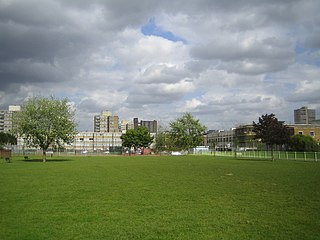
Bartlett Park is a public open space in Poplar in the London Borough of Tower Hamlets in London on Upper North Street. It is located to the south of the Limehouse Cut waterway and the Lansbury Estate to the south and east of the park. The whole landscape is 4.95 hectares.
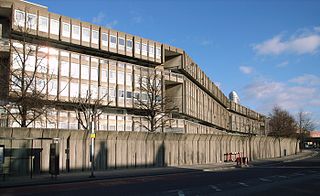
Robin Hood Gardens is a residential estate in Poplar, London, designed in the late 1960s by architects Alison and Peter Smithson and completed in 1972. It was built as a council housing estate with homes spread across 'streets in the sky': social housing characterised by broad aerial walkways in long concrete blocks, much like the Park Hill estate in Sheffield; it was informed by, and a reaction against, Le Corbusier's Unité d'Habitation. The estate was built by the Greater London Council, but subsequently the London Borough of Tower Hamlets became the landlord.
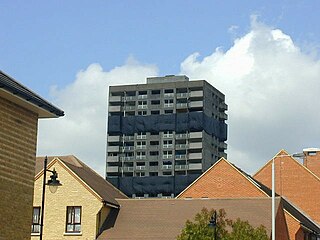
Cathall is a housing estate in the Cathall ward, Leytonstone, East London. It is currently managed by Community-based Housing Association.

Market Estate is a public housing estate consisting of 271 flats and maisonettes situated to the north of Caledonian Park in the London Borough of Islington. It is named after the Metropolitan Cattle Market which operated on the site until the 1960s. After slaughter the carcasses of cattle and sheep were sent by underground trains to Smithfield Market to be traded. Three of the six blocks that make up the estate are named after breeds of animal that were traded in the market: Tamworth (pigs), Kerry (cows) and Southdown (sheep). The remaining three blocks are called the Clock tower blocks after the market's clock tower which still stands in Caledonian Park. This contains a working clock used as a prototype for the mechanism of Big Ben.

Roundshaw is a housing estate and park in south Wallington and Beddington on the eastern edge of the London Borough of Sutton. Grid Ref TQ302633.

Poplar and Limehouse is a constituency created in 2010 and represented in the House of Commons of the UK Parliament since 2019 by Apsana Begum of the Labour Party. From its creation until 2019, it was represented by Jim Fitzpatrick, also of Labour.
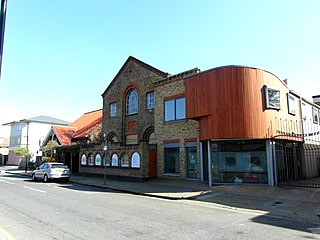
The Bromley by Bow Centre is a community centre in Bromley-by-Bow, in East London. It was founded by Andrew Mawson in 1984 alongside community members such as Chilean artist Santiago Bell, with the aim of transforming the local community. Over the years, the centre has grown to encompass a GP surgery where Sam Everington is an enthusiastic advocate of the centre, church, nursery, children's centre, community facilities and a cafe. It is the site of the UK's first Healthy Living Centre, and around 2,000 people use the Centre each week. In addition to team members such as psychologists, nurses, counsellors, and phlebotomists, the centre also houses artists, stonemasons, gardeners, and stained-glass makers.
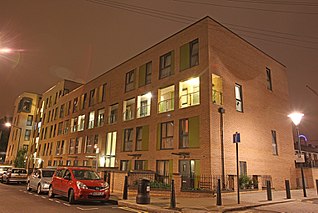
Poplar HARCA is a housing association in London, England. It is the landlord of about 9,000 homes in the East London area, a quarter of which have been sold leasehold; the remainder are let on assured tenancies at subsidised rent levels.
Coventry Cross may refer to:

The Cranbrook Estate is a housing estate in Bethnal Green, London, England. It is located next to Roman Road and is based around a figure of eight street called Mace Street. The estate was designed by Francis Skinner, Douglas Bailey and an elder mentor, the Soviet émigré Berthold Lubetkin.

Draped Seated Woman 1957–58 is a bronze sculpture by the British artist Henry Moore, cast in an edition of seven in the 1950s. The sculpture depicts a female figure resting in a seated position, with her legs folded back to her right, her left hand supporting her weight, and her right hand on her right leg. The drapery emphasises the female figure, but the facial features are abstracted and barely picked out.

Public housing in the United Kingdom, also known as council housing or social housing, provided the majority of rented accommodation until 2011 when the number of households in private rental housing surpassed the number in social housing. Dwellings built for public or social housing use are built by or for local authorities and known as council houses. Since the 1980s non-profit housing associations became more important and subsequently the term "social housing" became widely used, as technically council housing only refers to housing owned by a local authority, though the terms are largely used interchangeably.

Aberfeldy Village is an urban village in a part of Poplar that was once part of Bromley in London, England, which is in the process of being redeveloped in a joint venture between Poplar HARCA and Willmott Dixon. It was known as the Aberfeldy Estate, a housing estate but has expanded into a new urban village. It is sometimes referred to as Aberfeldy New Village in planning documents.